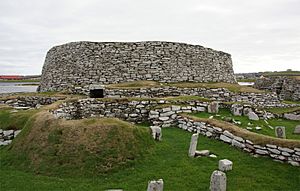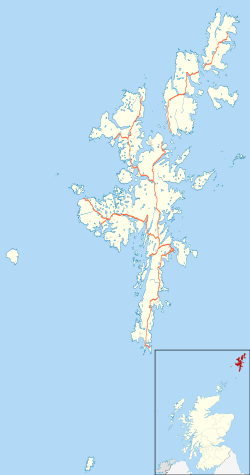Broch of Clickimin facts for kids

Broch of Clickimin
|
|
| Location | Mainland, Shetland |
|---|---|
| Coordinates | 60°08′57″N 1°09′56″W / 60.149289°N 1.165543°W |
| Type | Broch |
| History | |
| Periods | Iron Age |
| Site notes | |
| Ownership | Historic Scotland |
| Official name | Clickimin Broch,broch and settlement |
| Designated | 18 August 1882 |
| Reference no. | SM90077 |
The Broch of Clickimin is an amazing ancient stone tower in Lerwick, Shetland, Scotland. It's a special type of building called a broch, which was built a very long time ago. This broch was first built on an island in Clickimin Loch. People reached it by walking across a stone path.
The broch sits inside a walled area. It also has a unique stone structure called a "blockhouse" near its entrance. This site is looked after by Historic Scotland. Experts believe people lived here during many different times. They built farms, a fort, the broch, and even a wheelhouse over hundreds of years.
Contents
Where is the Broch of Clickimin?
The Broch of Clickimin is found on the south side of Clickimin Loch. It's about three-quarters of a mile southwest of Lerwick. You can see it from the main road that goes to Sumburgh. The broch sits on a small piece of land that sticks out into the loch. It is one of the best-kept broch sites in all of Shetland.
What Does the Broch Look Like?
The Broch of Clickimin is a large, round stone tower. Its outer wall is about 20 meters (65 feet) across. The inside space is about 9 meters (30 feet) across. A strong stone wall surrounds the broch, forming a fort. This fort includes a "blockhouse" and a "ringwork."
Exploring the Blockhouse and Entrance
The blockhouse is a stone gateway built right inside the fort's entrance. It's like a mini-fort itself. To get into the main broch, you go through an entrance on its western side. This entrance passage might have had a small hidden room, called a "guard cell," on the right. This cell is now blocked up.
Inside the Broch Tower
Inside the broch, there are two small rooms built into the thick walls at ground level. When archaeologists dug here, they found holes where wooden posts once stood. This shows that there were timber buildings inside the broch. In the 1800s, people could still see stone walls radiating out from the center.
The broch also has two more entrances higher up. One entrance leads to the inside of the tower and to a staircase. The other entrance leads to a secret passage inside the wall, called an "intramural gallery."
A Journey Through Time: The Broch's History
The Broch of Clickimin was first dug up and cleared in 1861-1862. Later, some parts of the site were damaged. So, between 1908 and 1910, the Office of Works rebuilt parts of it.
More digging happened from 1953 to 1957. An archaeologist named J. R. C. Hamilton studied the site. He believed people lived here in many different stages:
- Late Bronze Age Farm (around 7th or 6th centuries BC): The first people built a small farm here.
- Early Iron Age Farm (around 5th century BC): A larger, round farmhouse was built.
- Stone Fort (around 4th or 3rd century BC): A strong stone fort with a blockhouse and ringwork was added.
- Broch Period (around 1st century AD): The tall broch tower was built.
- Wheelhouse Settlement (around 2nd and 3rd centuries AD): A large wheelhouse was built inside the broch. People also dug storage pits and cattle stalls.
Recently, some experts have questioned Hamilton's ideas. They now think that the ring wall, blockhouse, and the broch might have all been built around the same time.
What Was Found at the Broch?
Archaeologists found many interesting objects at Clickimin Broch. These finds help us understand what life was like for the people who lived there. Some of the things they found include:
- Stone lamps (for light)
- Whetstones (for sharpening tools)
- Objects made from bone and whalebone
- A die (for games)
- A few bronze objects
- Two small pieces of Roman glass
Images for kids






